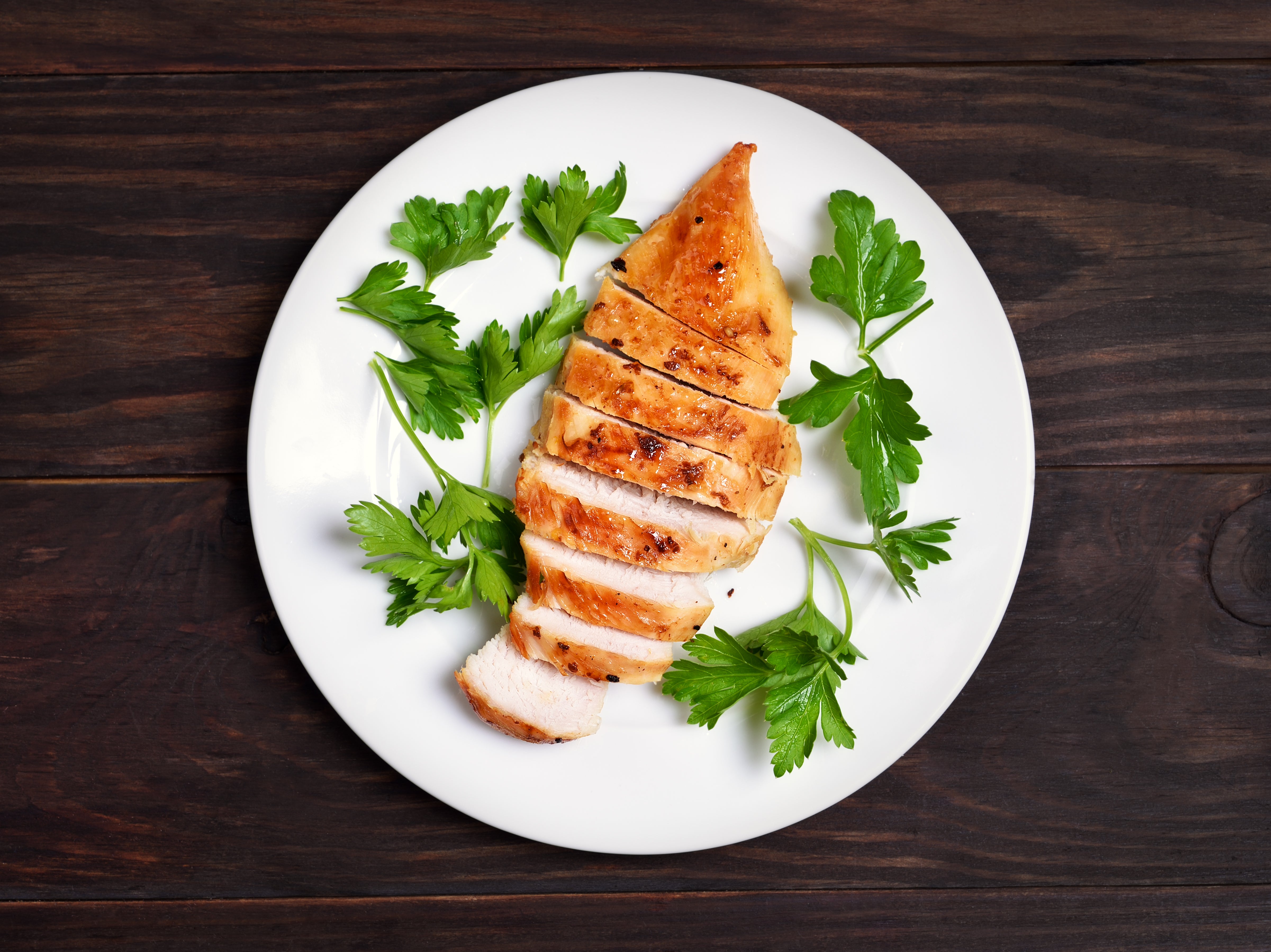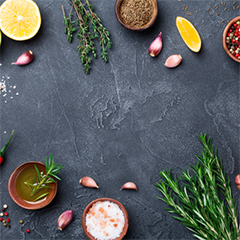In the 1723 cookery book The Cooks and Confectioners Dictionary, author John Nott shares a recipe for chicken breasts, in which the skins get lifted and stuffed with grated bacon, anchovies and herbs. According to the Oxford English Dictionary, it’s one of the first written accounts of the noun cluster “chicken breasts” in the English language. It’s also a great way to cook white meat so that it doesn’t dry out.
One major design flaw of the chicken breast is that its thickness varies significantly from end to end. This makes for vexingly uneven cooking – especially when the meat comes boneless and skinless. By the time the wide, bulbous side has cooked through, the lither, tapered side (not to mention the outer edges of the entire breast) has gone stringy, practically desiccated.
But here’s the thing: you don’t have to accept that ugly lopsidedness. Take control of your life – and your chicken.
The trick to keeping breast meat tender and juicy is to alter its anatomy completely. There are a few key ways to do this. The easiest is to carve the breast in half crosswise where the thicker end meets the thinner end. This way you can pull the thinner pieces off the heat earlier, allowing the thicker ones to finish cooking for another minute or two.
Another method is to ensure the meat retains its natural moisture. What makes a chicken breast juicy is water, not fat (after all, white meat is very lean). A simple dry brine – a mixture of salt, sugar and spices – provides that bit of insurance. It’s the salt that’s most crucial, as it draws out the meat’s water. That water then dissolves the salt on the surface of the meat and, through diffusion, the two re-enter the meat, seasoning the chicken thoroughly.
As evidenced by Volume 3 of Modernist Cuisine: The Art and Science of Cooking, dissolved salt modifies the protein structure of meat, allowing it to hold onto water by slowing the contraction of muscle fibres during the cooking process. This contraction ordinarily “squeezes juices out during cooking,” but a dry brine rewards you with retained juiciness.
A marinade can yield similarly juicy results through different means. In the following stir-fry recipe, a group of enzymes in fresh pineapple, bromelain, breaks down the connective tissues of fibrous chicken, turning the otherwise taut meat into slackened nuggets. Watch and be amazed as this powerful potion transforms tough, plain white meat into a supple dark-meat doppelgänger.
But proceed with caution: marinate the chicken too long and you’ll end up with gluey shreds of meat. Fifteen minutes is the Goldilocks time, which is to say, just right.
Other acidic ingredients have similar benefits. The lactic acid in sour cream tenderises chicken beautifully and also helps crunchy, savoury coatings stick to the meat. Smear it all over chicken breasts and encase them in a thick coating of buttery Ritz cracker crumbs and grated sharp cheddar for a result equal parts moist and crisp.
This comforting chicken bake tastes best with cutlets, which are always a great weeknight option. Although you could pound a thick breast out into a thin paillard (which also breaks down the fibres of the meat), another less violent approach is to slice through the middle of the breast horizontally so you’re left with two cutlets of equal size. As with most things in life, two is better than one.
Dry-brined chicken breasts
Makes: 4 servings
Total time: 55 minutes
Ingredients
5 dried bay leaves, crushed into small pieces
1 tsp whole black peppercorns
2½ tsp salt
1 packed tbsp dark brown sugar
2 tsp garlic powder
2 large boneless, skinless chicken breasts (about 680g total)
Vegetable oil
Lime wedges, for serving (optional)
Method
1. In a spice grinder or pestle and mortar, blitz the bay leaf pieces and peppercorns until finely ground. Transfer to a small bowl and add the salt, brown sugar and garlic powder, and rub it all together with your fingers.
2. Cut each chicken breast in half crosswise into two pieces of equal weight, creating one shorter, thicker piece and one longer, thinner piece. Place the four chicken pieces on a large plate or baking tray and sprinkle generously on all sides with the spice mixture, moving the chicken around to catch any fallen spices. Refrigerate, uncovered, to dry-brine for at least 30 minutes and up to 1 hour (any shorter and the osmotic brining process won’t complete; any longer and you’ll end up with deli meat).
3. When ready to cook, take the chicken out of the fridge and heat a large frying pan with a lid over high heat. Add enough oil to lightly coat the bottom of the pan. Carefully add the chicken pieces, smooth sides down, and immediately reduce the heat to medium-low. Cook until the bottoms are browned but not burned, 5 to 7 minutes. Flip the chicken, cover the pan and cook until the other sides are browned and the internal temperature at the thickest part of the meat reaches 70C, another 5 to 7 minutes. You may want to pull the longer, thinner pieces off the heat a minute or two sooner, as they may cook faster.
4. Transfer the chicken to a cutting board to rest for at least 10 minutes so the juices can redistribute. The meat will continue to cook as it sits and should reach an internal temperature of 75C. You can also check for doneness by cutting into the chicken; it should look white and juicy and no longer pink. Slice the chicken against the grain (that is, perpendicular to the parallel fibres that run within the breast) and serve with lime wedges if you’d like. You can also keep the meat whole and refrigerate it, covered, for up to 4 days.
Pineapple-marinated chicken breasts
Makes: 4 servings
Total time: 30 minutes
Ingredients
3 packed tbsp dark brown sugar
2 tbsp rice vinegar
1 tbsp soy sauce
1 tbsp fish sauce
2 tbsp olive oil, plus more for cooking
1 tsp kosher salt (Diamond Crystal)
1 tsp garlic powder
¼ to ½ tsp ground cayenne
½ tsp black pepper
1 cup diced fresh pineapple (1.5cm chunks)
¼ cup finely diced red onion
2 tbsp finely chopped fresh coriander
2 tbsp finely grated fresh pineapple, including accumulated juices
680g boneless, skinless chicken breasts, cut into 4cm chunks
Cooked white rice, for serving
Method
1. In a large bowl, stir together the brown sugar, rice vinegar, soy sauce, fish sauce, 2 tablespoons olive oil, salt, garlic powder, ground cayenne and black pepper. Transfer 1 tablespoon of this marinade mixture to a separate medium bowl and add the diced pineapple, red onion and coriander. This is your salsa; toss until well mixed and set aside.
2. Add the grated pineapple and its juices to the marinade mixture in the large bowl, then add the chicken and toss to coat. Set aside to marinate at room temperature for 15 minutes (and no longer).
3. Once the chicken is done marinating, heat a large nonstick frying pan over medium-high and add enough olive oil to lightly coat the bottom of the pan. Add the chicken pieces, leaving any marinade behind, in a single layer so that they don’t touch and let cook until the bottoms are browned, 2 to 3 minutes. Continue cooking, stirring occasionally, until browned on all sides and no longer pink on the inside, 4 to 5 minutes more.
4. Serve the chicken over rice and top with the reserved pineapple salsa.
Ritzy cheddar chicken breasts
Makes: 4 servings
Total time: 30 minutes
Ingredients
1 tbsp olive oil, plus more for greasing wire rack
¼ cup sour cream
1 large egg white
1 tsp Dijon mustard
Salt
2 large boneless, skinless chicken breasts (about 680g total)
1 sleeve Ritz crackers (about 100g)
60g extra-sharp cheddar cheese, coarsely grated
½ tsp garlic powder
½ tsp onion powder
Method
1. Position rack in the bottom third of the oven and heat oven to 230C. Place an ovenproof wire rack over a baking tray. Dab a folded-up paper towel with olive oil and rub it over the wire rack to grease it.
2. In a medium bowl, whisk together the sour cream, egg white and Dijon mustard until smooth. Season with salt. Lay the chicken flat on a cutting board and carve each breast in half laterally so you end up with four thin cutlets. Add the chicken to the sour cream mixture, and using your hands, smear the sour cream all over the chicken.
3. In a large bowl, crush the Ritz crackers into coarse pieces your fingers. Some crackers will turn to rubble while others turn to dust. Add the cheese, garlic powder, onion powder and olive oil. Season with ½ teaspoon salt and toss until evenly distributed. Holding one of the chicken cutlets by its thinner end, add to the bowl with the crumbs, and using your hands, pack the crumbs onto the chicken, pressing them in to create a thick coating. Transfer the breaded chicken to the rack in the sheet pan. Repeat with the remaining three cutlets.
4. Bake the cutlets until the outsides are crispy and the insides are no longer pink, 10 to 15 minutes. Let the chicken cool slightly so the coating can set, about 5 minutes, before transferring to plates and serving.
And to drink…
The tangy, umami flavours of Ritzy cheddar chicken breasts would go awfully well with a rich, balanced chardonnay, whether from Oregon, California, Australia or Burgundy. I often warn against oak flavours in wine, and I never want overt oakiness. But with this dish, a chardonnay with the textural and subtle flavour additions of well-integrated oak would be delightful. Sparkling wines like Champagne or Vouvray Brut would also be delicious. You could drink a still Vouvray as well or a Savennières, both Loire Valley whites made with the chenin blanc grape. As for the pineapple-marinated chicken breast, the sweetness of the fruit offers an opportunity for a sweet wine. Try a spätlese riesling, or even a sweeter auslese. A demi-sec Vouvray, a Tokaji Aszu or even a Sauternes would be great fun with this dish.
Drinks reporting by Eric Asimov
© The New York Times
Subscribe to Independent Premium to bookmark this article
Want to bookmark your favourite articles and stories to read or reference later? Start your Independent Premium subscription today.


Join our commenting forum
Join thought-provoking conversations, follow other Independent readers and see their replies